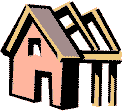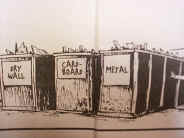Green Building Management of Residential
Construction Waste for The Single Family Home Building Contractor
Some Generalizations
- By weight or volume, wood, drywall, and cardboard make up between 60% and 80% of job site waste.
 Vinyl and metals are generated in small quantities but have good recycling value.
Vinyl and metals are generated in small quantities but have good recycling value.
- Cardboard waste is increasing on most job sites as more components – windows, appliances, cabinets, siding – are shipped to builders over long distances.
- Most wood waste is "clean" – unpainted, untreated, and recyclable. The term "clean" usually includes dimensional lumber, plywood, and particle board without laminates.
- Brick, block, and asphalt shingle waste are insignificant in volume but can be important in terms of weight.
- For most builders, the largest share of waste that could be considered hazardous is generated from painting, sealing, staining, and caulking.
- Drive-by contamination (waste placed in a container by a party other than the builder/subcontractor) can be as much as 30 percent of the total volume hauled from a site.
Estimated Percentages (for a typical 3-4 bedroom home)
| Predominant Materials |
Rough % |
| Wood |
20-35% |
| Drywall |
10-20% |
| Corrugated Cardboard |
5-15% |
| Secondary Materials |
Rough % |
| Shingles |
1-8% |
| Concrete |
1-8% |
| Fiberboard |
1-8% |
Materials comprising 1% or less. Listed in approximate order of quantity, from more to less
- Fiberglass insulation
- Carpet scrap, padding, and backing
- Kraft paper
- Sheathing
- Aluminum siding
- Vinyl siding
- Concrete block
- Copper wire
- Other wire
- PVC pipe
- Core cardboard
- Plastic buckets
- Dirt and rock from excavation
- Aluminum duct-work
- Foam packaging
- Plastic sheeting or bags
- Steel banding
- Lunch garbage, pop cans
- Plastic pails
- Paint cans
- Flooring scrap
Materials comprising less than 1% but notable because they are considered hazardous materials:
- Paint
- Driveway sealant (pails)
- Caulk (tubes)
- Tile adhesive (cans)
Calculating Amounts Of Construction Waste
The following are ballpark figures to estimate how much waste your project will generate.
| Material |
Lbs./Sq.Ft. |
| Wood |
1.3 – 2.1 |
| Drywall |
1.0-1.2 |
| Cardboard |
0.1-0.5 |
| Metals |
0.02-0.13 |
| Other Waste (plastics, shingles, etc.) |
0.5-1.3 |
TOTAL 3.0-5.2
NOTE: Range for wood waste depends on material used for wall sheathing, siding, trim, and roofing. Range for cardboard depends on type of siding and whether windows, doors, and cabinetry are locally manufactured.
How To Manage Residential Construction Waste
In Connecticut, the easiest and most common way to manage construction waste is to commingle most waste into one roll-off where it is taken by the hauler to a materials recovery facility or transfer station. The C&D is then sorted for markets and the remaining wastes are consolidated for disposal at landfills.
 Contractors can improve upon this system by using separate dumpsters for cardboard, clean wood, and scrap metal which will be more marketable. Corrugated cardboard and scrap metal are mandatory recyclables in Connecticut and must be separated from other building material wastes. All hazardous materials and clean fill (rock, brick, concrete and asphalt) should be separated from the rest of the C&D waste stream. Finally, investigate the possibility of additional markets for items such as drywall, plastics, shingles, fiberboard, and any particular waste that may be generated in large quantities.
Contractors can improve upon this system by using separate dumpsters for cardboard, clean wood, and scrap metal which will be more marketable. Corrugated cardboard and scrap metal are mandatory recyclables in Connecticut and must be separated from other building material wastes. All hazardous materials and clean fill (rock, brick, concrete and asphalt) should be separated from the rest of the C&D waste stream. Finally, investigate the possibility of additional markets for items such as drywall, plastics, shingles, fiberboard, and any particular waste that may be generated in large quantities.
Follow these additional waste minimization guidelines:
Lumber
Optimize building dimensions to correspond to standard lumber dimensions.
Modify framing details to optimize lumber use and reduce waste and inform framing contractor of your plan.
Develop detailed framing layouts to avoid waste when ordering lumber.
Store lumber on level blocking under cover to minimize warping, twisting, and waste.
Set aside lumber and plywood/oriented strand board (OSB) cut-offs that can be used later as fire blocking, spacers in header construction, etc.
In remodeling, evaluate whether salvaging used lumber is possible.
Save small wood scraps to use as kindling for clients or crew members (no treated wood).
Larger pieces of leftover lumber (6' or more in length) can be donated.
Save clean sawdust for use in compost piles or around gardens. Avoid sawdust that might contain painted or treated wood. This should be bagged separately and sent to appropriate permitted DEEP facilities that volume reduce or landfill treated wood waste.
Gypsum Wallboard or Drywall
Order drywall in optimal dimensions to minimize cut-off waste. Drywall is available in different lengths, and designed dimensions should correspond to standard sizes.
Large drywall scraps can be set aside during hanging for use as filler pieces in small hidden areas such as closets.
Donate large pieces of drywall, full to half sheets.
Reuse joint compound buckets for tool or material storage by clients or crews.
Masonry
Estimate masonry material needs carefully to avoid waste.
During construction, collect, stack and cover brick and other masonry materials to prevent soiling or loss.
Clean concrete chunks, old brick, broken blocks, and other masonry rubble can be used as back-fill along foundation walls.
Salvage usable bricks, blocks, slate shingles, tile and other masonry materials from remodeling and construction. Store for future jobs or divert to salvage operations.
Ask your masonry supplier to accept the return of materials in good condition.
For the disposal of large amounts of aggregate, contact DEEP for a list of Construction and Demolition Aggregate Recycling Facilities.
Metals and Appliances
During remodeling, separate metal radiators, grates, piping, aluminum siding, and old appliances for salvage or recycling.
During construction, separate metals for recycling, including copper piping, wire and flashing, aluminum siding, flashing and guttering; iron and steel banding from bundles, nails and fasteners, galvanized flashing and roofing, and rebar; and lead chimney flashing.
Cardboard and Paper
Avoid excessively packaged materials and supplies. Packaging should be adequate to prevent damage and waste.
Separate, as per state law, cardboard waste. Bundle and store in a dry place. Recycle through your hauler or transfer station.
Minimize the number of blueprints and reproductions necessary during the design and construction process.
Insulation
Install left-over insulation in interior wall cavities or on top of installed attic insulation if it cannot be used on another job.
Asphalt Roofing
Donate unused left over bundled shingles.
Leave some shingles with homeowner for replacement needs.
Do not bury asphalt shingles. Shingles contain hydrocarbons which are carcinogenic.
Plastic and Vinyl
Minimize waste of vinyl siding, flooring and countertop materials by ordering only quantity needed.
Paints, Stains, Solvents and Sealants
Donate unused portions to the material exchanges listed below and Habitat for Humanity.
Save unused portions for future jobs.
Allow empty cans or cans with small amounts of latex based paint to dry out before disposing.
Old or unusable portions of oil based paints, stains, and sealants can be brought to a commercial hazardous waste or regulated waste facility. Call ahead for their acceptance policy and pricing. DEEP will allow a builder to self-transport up to 1,000 kg/month in his own truck to a permitted treatment, storage or disposal facility (TSDF). The TSDF will require a manifest, but most likely will fill it out for the builder's signature. An EPA identification is not required. For more information on hazardous wastes and a list of permitted facilities, contact the Waste Engineering and Enforcement Division of the Bureau of Materials Management and Compliance Assurance at (860) 424-3366.
Miscellaneous
Branches and trees from brush clearing can be stored separately and chipped on-site. Chipped land-clearing debris and yard waste can be used in landscaping substrates, compost bulking agents, soil amendments, and in temporary land stabilization projects in a manner that poses no threat to surface or ground water.
Rock, brick, ceramics, concrete, and asphalt paving fragments are virtually inert and can be used as clean fill.
Never use asphalt shingles, gypsum wallboard, oriented strand board, particleboard, pressure treated lumber, painted lumber, or other treated wood as a soil amendment or in a fill condition.
Excess brush and yard waste can be brought to a permitted DEEP facility. Call the DEEP Recycling Program at (860) 424-3366 for a list of facilities.
Old nickel cadmium batteries from portable power tools should not be thrown away with other solid waste. Contact the Rechargeable Battery Recycling Coalition at 1-800-8-Battery. Home Depot also has a collection program.
Cabinets, light fixtures, bathtubs, sinks, mortar mix, hardware, nails, screws, and plumbing fittings and supplies may be donated to the organizations listed below.
Donation Opportunities
The following organizations may be interested in your unused construction materials:
This information is provided as a service to those professionals in the construction industry. This information does not include all available references and does not constitute an endorsement by DEEP. Use of this information does not in any way lessen your responsibilities for compliance with applicable federal, state, and local laws.
Content Last Updated February 2020
 Vinyl and metals are generated in small quantities but have good recycling value.
Vinyl and metals are generated in small quantities but have good recycling value.
 Contractors can improve upon this system by using separate dumpsters for cardboard, clean wood, and scrap metal which will be more marketable. Corrugated cardboard and scrap metal are mandatory recyclables in Connecticut and must be separated from other building material wastes. All hazardous materials and clean fill (rock, brick, concrete and asphalt) should be separated from the rest of the C&D waste stream. Finally, investigate the possibility of additional markets for items such as drywall, plastics, shingles, fiberboard, and any particular waste that may be generated in large quantities.
Contractors can improve upon this system by using separate dumpsters for cardboard, clean wood, and scrap metal which will be more marketable. Corrugated cardboard and scrap metal are mandatory recyclables in Connecticut and must be separated from other building material wastes. All hazardous materials and clean fill (rock, brick, concrete and asphalt) should be separated from the rest of the C&D waste stream. Finally, investigate the possibility of additional markets for items such as drywall, plastics, shingles, fiberboard, and any particular waste that may be generated in large quantities.
